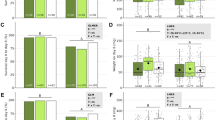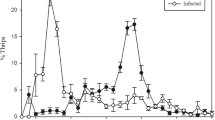Abstract
Strains IMI 330189 of Metarhizium acridum (Driver & Milner) J.F. Bisch., Rehner & Humber (Hypocreales: Clavicipitaceae) and EABb 90/2-Dm of Beauveria bassiana (Bals.-Criv.) Vuill. (Hypocreales: Cordycipitaceae) are a promising biocontrol tool of Dociostaurus maroccanus (Thunberg) (Orthoptera: Acrididae), although the effects of thermoregulation and Moroccan locust-fever on the infection process of these fungi remain unknown. In vitro experiments, measuring conidial germination and hyphal growth either at constant or at fluctuating temperatures simulating thermoregulatory conditions, indicated that strain IMI 330189 had greater fitness at temperatures above 27 °C and the strain EABb 90/2-Dm was better adapted to the temperature range of 10–25 °C. These effects were mirrored in vivo, where locust thermoregulation caused a marked reduction in the virulence of EABb 90/2-Dm in comparison to no thermoregulation conditions (average survival time: 6.10 vs. 15.83 days; mortality: 100% vs. 73.7%) but only a moderate reduction in the virulence of IMI 330189 (average survival time: 4.57 vs. 8.26 days; mortality: 100% vs. 100%). Thermal gradient experiments revealed that the strain IMI 330189 induced behavioral fever in D. maroccanus (preferred temperatures approximately 4 °C above the uninfected control), although it only led to a slight reduction in virulence. Strain EABb 90/2-Dm did not induce such a clear behavioral response. Under the temperature conditions of the main breeding areas of the Moroccan locust, strain IMI 330189 is likely a better candidate for use in biocontrol, although strain EABb 90/2-Dm could be also a good alternative in more temperate environments either as a stand-alone one or in mixed combinations of the two fungal strains, potentially providing more effective control over a broader range of temperatures.



Similar content being viewed by others
References
Anderson RD, Blanford S, Jenkins NE, Thomas MB (2013a) Discriminating fever behavior in house flies. PLoS ONE 8(4):e62269. https://doi.org/10.1371/journal.pone.0062269
Anderson RD, Blanford S, Thomas MB (2013b) House flies delay fungal infection by fevering: at a cost. Ecol Entomol 38:1–10
Arthurs S, Thomas MB (2001) Effects of temperature and relative humidity on sporulation of Metarhizium anisopliae var. acridum in mycosed cadavers of Schistocerca gregaria. J Invertebr Pathol 78:59–65
Bidochka MJ, Kasperski JE, Wild GAM (1998) Occurrence of the entomopathogenic fungi Metarhizium anisopliae and Beauveria bassiana in soils from temperate and near-northern habitats. Can J Bot-Rev Can Bot 76:1198–1204
Bidochka MJ, Melzer MJ, Lavender TM, Kamp AM (2000) Genetically related isolates of the entomopathogenic fungus Metarhizium anisopliae harbour homologous dsRNA viruses. Mycol Res 104:1094–1097
Bidochka MJ, Menzies FV, Kamp AM (2002) Genetic groups of the insect-pathogenic fungus Beauveria bassiana are associated with habitat and thermal growth preferences. Arch Microbiol 178:531–537
Blanford S, Thomas MB (2000) Thermal behavior of two acridid species: effects of habitat and season on body temperature and the potential impact on biocontrol with pathogens. Environ Entomol 29:1060–1069
Blanford S, Thomas MB, Langewald J (1998) Behavioral fever in the Senegalese grasshopper, Oedaleus senegalensis, and its implications for biological control using pathogens. Ecol Entomol 23:9–14
Carruthers RI, Larkin TS, Firstencel H, Feng ZD (1992) Influence of thermal ecology on the mycosis of a rangeland grasshopper. Ecology 73:190–204
Chappell MA, Whitman DW (1990) Grasshopper thermoregulation. In: Chapman RF (ed) Biology of grasshoppers. Wiley Interscience, New York, pp 143–172
Collar-Urquijo JL, Celma-Calamita J, Blandford S, Thomas MB (2002) Control de Dociostaurus maroccanus y Calliptamus italicus (Orthoptera: Acrididae) mediante aplicaciones en campo de Metarhizium anisopliae var acridum. Bol San Veg Plagas 28:185–192
Darbro JM, Graham RI, Kay BH, Ryan PA, Thomas MB (2011) Evaluation of entomopathogenic fungi as potential biological control agents of the dengue mosquito, Aedes aegypti (Diptera: Culicidae). Bicontrol Sci Technol 21:1027–1047
Elliot SL, Blanford S, Thomas MB (2002) Host-pathogen interactions in a varying environment: temperature, behavioural fever and fitness. Proc R Soc Lond Ser B-Biol Sci 269:1599–1607
Elliot SL, Blanford S, Horton CM, Thomas MB (2003) Fever and phenotype: transgenerational effect of disease on desert locust phase state. Ecol Lett 6:830–836
Fargues J, Goettel MS, Smits N, Ouedraogo A, Rougier M (1997a) Effect of temperature on vegetative growth of Beauveria bassiana isolates from different origins. Mycologia 89:383–392
Fargues J, Ouedraogo A, Goettel MS, Lomer CJ (1997b) Effects of temperature, humidity and inoculation method on susceptibility of Schistocerca gregaria to Metarhizium flavoviride. Biocontrol Sci Technol 7:345–356
Fisher JJ, Hajek AE (2014) Thermoregulatory behavior and fungal infection of Anoplophora glabripennis (Coleoptera: Cerambycidae). Environ Entomol 43:384–392
Henke MO, de Hoog GS, Gross U, Zimmerman G, Kraemer D, Weig M (2002) Human deep tissue infection with an entomopathogenic Beauveria species. J Clin Microbiol 40:2698–2702
Hernandez-Crespo P, Santiago-Álvarez C (1997) Entomopathogenic fungi associated with natural populations of the Moroccan locust Dociostaurus maroccanus (Orthoptera: Gomphocerinae) and other Acridoidea in Spain. Biocontrol Sci Technol 7:357–363
Hunt VL, Charnley AK (2011) The inhibitory effect of the fungal toxin, destruxin A, on behavioural fever in the desert locust. J Insect Physiol 57:1341–1346
Hunt VL, Lock GD, Pickering SG, Charnley AK (2011) Application of infrared thermography to the study of behavioural fever in the desert locust. J Therm Biol 36:443–451
Inglis GD, Johnson DL, Goettel MS (1996) Effects of temperature and thermoregulation on mycosis by Beauveria bassiana in grasshoppers. Biol Control 7:131–139
Inglis GD, Duke GM, Kawchuk LM, Goettel MS (1999) Influence of oscillating temperatures on the competitive infection and colonization of the migratory grasshopper by Beauveria bassiana and Metarhizium flavoviride. Biol Control 14:111–120
Inglis GD, Goettel MS, Butt TM, Strasser H (2001) Use of hyphomicetous fungi for managing insect pests. In: Butt TM, Jackson CW, Magan N (eds) Fungi as biocontrol agents: progress, problems and potential. CABI International, Wallingford, pp 23–69
Jaronski ST (2010) Ecological factors in the inundative use of fungal entomopathogens. BioControl 55:159–185
Jiménez-Medina J, Aldebis HK, Santiago-Alvarez C (1998) Valoración insecticida de diversos aislados de hongos hifomicetos para el control de la langosta mediterránea, Dociostaurus maroccanus (Thunberg). Bol San Veg Plagas 24:867–872
Keyser CA, Fernandes EKK, Rangel DEN, Roberts DW (2014) Heat-induced post-stress growth delay: a biological trait of many Metarhizium isolates reducing biocontrol efficacy? J Invertebr Pathol 120:67–73
Klass JI, Blanford S, Thomas MB (2007) Development of a model for evaluating the effects of environmental temperature and thermal behaviour on biological control of locusts and grasshoppers using pathogens. Agric For Entomol 9:189–199
Klinger EG, Vojvodic S, DeGrandi-Hoffman G, Welker DL, James RR (2015) Mixed infections reveal virulence differences between host-specific bee pathogens. J Invertebr Pathol 129:28–35
Latchininsky AV, Launois-Luong MH (1992) Le criquet marocain, Dociostaurus maroccanus (Thunberg, 1815) dans la partie orientale de son aire de distribution. Etude monographique à l’ex-URSS et aux pays proches. Montpellier/VIZR, Saint-Petersbourg
Liu HP, Skinner M, Brownbridge M, Parker BL (2003) Characterization of Beauveria bassiana and Metarhizium anisopliae isolates for management of tarnished plant bug, Lygus lineolaris (Hemiptera: Miridae). J Invertebr Pathol 82:139–147
Lomer CJ, Bateman RP, Johnson DL, Langewald J, Thomas M (2001) Biological control of locusts and grasshoppers. Annu Rev Entomol 46:667–702
Milner RJ, Staples JA, Prior C (1996) Laboratory susceptibility of Locusta migratoria (L), Austracris guttulosa (Walker) and Valanga irregularis (Walker) (Orthoptera: Acrididae) to an oil formulation of Metarhizium flavoviride Gams and Rozsypal (Deuteromycotina: Hyphomycetes). Aust J Entomol 35:355–360
Ouedraogo A, Fargues J, Goettel MS, Lomer CJ (1997) Effect of temperature on vegetative growth among isolates of Metarhizium anisopliae and M. flavoviride. Mycopathologia 137:37–43
Ouedraogo RM, Kamp A, Goettel MS, Brodeur J, Bidochka MJ (2002) Attenuation of fungal infection in thermoregulating Locusta migratoria is accompanied by changes in hemolymph proteins. J Invertebr Pathol 81:19–24
Ouedraogo RM, Goettel MS, Brodeur J (2004) Behavioral thermoregulation in the migratory locust: a therapy to overcome fungal infection. Oecologia 138:312–319
Quesada-Moraga E (1998) Biología y ecología de la reproducción y desarrollo embrionario de la langosta mediterránea Dociostaurus maroccanus (Thunberg) y su posible interferencia como estrategia de lucha. PhD Thesis, University of Cordoba. Spain
Quesada-Moraga E, Santiago-Álvarez C (2001) Rearing and breeding of the Moroccan locust Dociostaurus maroccanus (Thunberg) (Orthop., Acrididae) under laboratory conditions. J Appl Entomol-Z Angew Entomol 125:121–124
Quesada-Moraga E, Maranhao EAA, Valverde-Garcia P, Santiago-Alvarez C (2006) Selection of Beauveria bassiana isolates for control of the whiteflies Bemisia tabaci and Trialeurodes vaporariorum on the basis of their virulence, thermal requirements, and toxicogenic activity. Biol Control 36:274–287
Rangel DEN, Fernandes EKK, Dettenmaier SJ, Roberts DW (2010) Thermotolerance of germlings and mycelium of the insect-pathogenic fungus Metarhizium spp. and mycelial recovery after heat stress. J Basic Microbiol 50:344–350
Robertson JL, Russell RM, Preisler HK, Savin NE (2007) Bioassays with arthropods, 2nd edn. CRC Press, Boca Raton
SAS (2015) JMP pro 12.2.0 SAS Institute Inc., Cary, NC
Springate S, Thomas MB (2005) Thermal biology of the meadow grasshopper, Chorthippus parallelus, and the implications for resistance to disease. Ecol Entomol 30:724–732
Stroup WW (2012) Generalized linear mixed models: modern concepts, methods and applications. CRC Press, Boca Raton
Thomas MB, Blanford S (2003) Thermal biology in insect-parasite interactions. Trends Ecol Evol 18:344–350
Thomas MB, Jenkins NE (1997) Effects of temperature on growth of Metarhizium flavoviride and virulence to the variegated grasshopper, Zonocerus variegatus. Mycol Res 101:1469–1474
Thomas MB, Watson EL, Valverde-Garcia P (2003) Mixed infections and insect-pathogen interactions. Ecol Lett 6:183–188
Tucker DL, Beresford CH, Sigler L, Rogers K (2004) Disseminated Beauveria bassiana infection in a patient with acute lymphoblastic leukemia. J Clin Microbiol 42:5412–5414
Vega FE, Kaya HK (2012) Insect pathology, 2nd edn. Academic Press, San Diego
Wang Y, Yang P, Cui F, Kang L (2013) Altered immunity in crowded locust reduced fungal (Metarhizium anisopliae) pathogenesis. PLoS Pathog 9(1):e1003102. https://doi.org/10.1371/journal.ppat.1003102
Yeo H, Pell JK, Alderson PG, Clark SJ, Pye BJ (2003) Laboratory evaluation of temperature effects on the germination and growth of entomopathogenic fungi and on their pathogenicity to two aphid species. Pest Manag Sci 59:156–165
Acknowledgements
We thank Dr. Elizabeth Maranhão and Dr. Karl D. Schnelle for their scientific collaboration and review of the document. This research was supported by the project AGL2016-80483-R from the Spanish Ministry of Science, Innovation and Universities. Dr. Inmaculada Garrido-Jurado thanks the Ministry of Economy and Competitiveness of the Spanish Government for a Juan de la Cierva post-doctoral Grant.
Author information
Authors and Affiliations
Corresponding author
Additional information
Handling Editor: Helen Roy.
Rights and permissions
About this article
Cite this article
Valverde-Garcia, P., Santiago-Alvarez, C., Thomas, M.B. et al. Comparative effects of temperature and thermoregulation on candidate strains of entomopathogenic fungi for Moroccan locust Dociostaurus maroccanus control. BioControl 63, 819–831 (2018). https://doi.org/10.1007/s10526-018-9904-6
Received:
Accepted:
Published:
Issue Date:
DOI: https://doi.org/10.1007/s10526-018-9904-6




